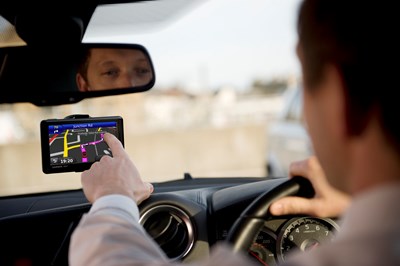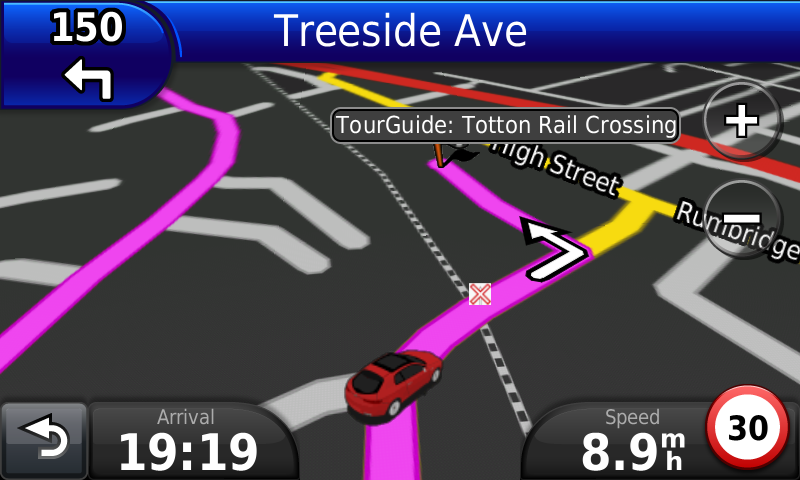Thursday 9 Jun 2011
SATNAV TECHNOLOGY TO HELP DRIVE DOWN WEST MIDS LEVEL CROSSING INCIDENTS
- Region & Route:
Satnav app launched as latest Langley Green level crossing CCTV images are released

Britain’s motorists are set to benefit from a world first in Satnav technology which will improve awareness of level crossings and encourage safer driving.
A free downloadable application which alerts drivers with a train whistle sound as they approach a level crossing has been developed by Network Rail and leading satellite navigation provider Garmin.
Network Rail route director Jo Kaye said: “Langley Green level crossing is a particular problem for us and we often have to stop the road barriers lowering because somebody is making a last minute dash across. Pedestrians and cyclists are just as guilty as car and lorry drivers, as our latest CCTV clips show. Stopping the barriers in mid sequence results in delays to trains and possibly missed connections for passengers.
“Vehicles weaving round lowering barriers or speeding through them pose a danger to themselves and other road users and pedestrians. There is also a real possibility that they will collide with the barrier, damaging both the level crossing equipment and the vehicle.
“Satnav technology has proved to be a great help to motorists in alerting them to what’s ahead on the road, so developing an app around level crossings seemed a smart idea. If we can reduce the number of incidents at level crossings we can save the taxpayer money and improve the punctuality and reliability of train services.”
It is hoped the new technology will encourage safer motoring and reduce the number of incidents which cause damage, disruption and a number of deaths each year. The news comes as the rail company is supporting international level crossing awareness day where around 40 countries are organising activities to promote safety at level crossings.
The free application can be downloaded onto Garmin nüvi or nüLink Satnavs from its website. Similar to choosing options that alert you to approaching speed cameras, the device whistles like a train and an ‘X’ appears on the screen with the name of the level crossing so motorists can approach and cross with care*. The companies are also looking into developing an intelligent version where motorists can choose to set a journey to avoid level crossings. They also want to develop the application so the Satnav would alter your route to avoid a level crossing where the barriers are down for a significant period of time, if the alternative was quicker.
Anthony Chmarny, Garmin head of communications said, “The development of this free level crossing application shows the ongoing commitment we have to ensure our Satnav customers have the very best travel information at the tip of their fingers. We believe this will help to save time, money and most importantly improve drivers’ safety during their journey.”
Acting Inspector Stuart Middlemas, of BTP, said: “Level crossings are perfectly safe when used correctly. Sadly, though, there are a number of people who seem content to take unnecessary risks at crossings just to save a few minutes.
“I cannot over-emphasise just how dangerous this is. The warning signs and barriers are there for a reason – to protect people – and those who fail to heed the warnings are putting themselves and others at risk.
“That some people are still prepared to run the risk of serious injury to knock seconds or minutes off their journey time is simply staggering.
“We will continue to take action against those who misuse crossings and will work with Network Rail to carry out further days of action to drive home the message that level crossings should be respected.”
Network Rail, British Transport Police, West Midlands Police and representatives from Centro will be at Langley Green level crossing during the morning (on 9 June) talking to motorists and pedestrians about the safe use of the crossing.
The app was launched on the day Network Rail released two new CCTV clips from Langley Green.
In one clip recorded in January 2011, a pedestrian is given a safety awareness leaflet by Network Rail staff. She is then seen dashing over the crossing, even though the lights are flashing and the warning klaxon is sounding. The barriers then have to be stopped from lowering and the pedestrian is spoken to by a police officer. She is then seen arguing with the officer and waving the safety leaflet at him. The woman was given a £50 on the spot fine for trespassing on the railway.
In the second clip (recorded in March 2011) two cyclists make a dash for the crossing even though the barrier sequence is well advanced. The first cyclist gets through unscathed but the second rides head first into the lowering barrier.
Notes to editors
* The Highway Code says:
Level crossings
291
A level crossing is where a road crosses a railway or tramway line. Approach and cross it with care. Never drive onto a crossing until the road is clear on the other side and do not get too close to the car in front. Never stop or park on, or near, a crossing.
293
Controlled crossings. Most crossings have traffic light signals with a steady amber light, twin flashing red stop lights (see 'Light signals controlling traffic' and 'Warning signs') and an audible alarm for pedestrians. They may have full, half or no barriers.
· you MUST always obey the flashing red stop lights
· you MUST stop behind the white line across the road
· keep going if you have already crossed the white line when the amber light comes on
· do not reverse onto or over a controlled crossing
· you MUST wait if a train goes by and the red lights continue to flash. This means another train will be passing soon
· only cross when the lights go off and barriers open
· never zig-zag around half-barriers, they lower automatically because a train is approaching
· at crossings where there are no barriers, a train is approaching when the lights show
[Laws RTA 1988 sect 36 & TSRGD regs 10 & 40]
295
Crossings without traffic lights. Vehicles should stop and wait at the barrier or gate when it begins to close and not cross until the barrier or gate opens.
296
User-operated gates or barriers. Some crossings have ‘Stop’ signs and small red and green lights. You MUST NOT cross when the red light is showing, only cross if the green light is on. If crossing with a vehicle, you should
· open the gates or barriers on both sides of the crossing
· check that the green light is still on and cross quickly
· close the gates or barriers when you are clear of the crossing
[Laws RTA 1988 sect 36 & TSRGD regs 10 & 52(2)]
297
If there are no lights, follow the procedure in Rule 295. Stop, look both ways and listen before you cross. If there is a railway telephone, always use it to contact the signal operator to make sure it is safe to cross. Inform the signal operator again when you are clear of the crossing.
298
Open crossings. These have no gates, barriers, attendant or traffic lights but will have a ‘Give Way’ sign. You should look both ways, listen and make sure there is no train coming before you cross.
About Garmin
The global leader in satellite navigation, Garmin Ltd. and its subsidiaries have designed, manufactured, marketed and sold navigation, communication and information devices and applications since 1989 – most of which are enabled by GPS technology. Garmin’s products serve automotive, mobile, wireless, outdoor recreation, marine, aviation, and OEM applications. Garmin Ltd. is incorporated in Switzerland, and its principal subsidiaries are located in the United States, Taiwan and the United Kingdom. For more information visit Garmin's media centre at http://garmin.blogs.com/ukpr. Garmin is a registered trademark of Garmin Ltd. or its subsidiaries. All other brands, product names, company names, trademarks and service marks are the properties of their respective owners. All rights reserved.
Contact information
Passengers / community members
Network Rail national helpline
03457 11 41 41
Latest travel advice
Please visit National Rail Enquiries
Journalists
Network Rail press office - North West & Central Region
0330 854 0100
NWCmediarelations@networkrail.co.uk
About Network Rail
We own, operate and develop Britain's railway infrastructure; that's 20,000 miles of track, 30,000 bridges, tunnels and viaducts and the thousands of signals, level crossings and stations. We run 20 of the UK's largest stations while all the others, over 2,500, are run by the country's train operating companies.
Usually, there are almost five million journeys made in the UK and over 600 freight trains run on the network. People depend on Britain's railway for their daily commute, to visit friends and loved ones and to get them home safe every day. Our role is to deliver a safe and reliable railway, so we carefully manage and deliver thousands of projects every year that form part of the multi-billion pound Railway Upgrade Plan, to grow and expand the nation's railway network to respond to the tremendous growth and demand the railway has experienced - a doubling of passenger journeys over the past 20 years.
Follow us on Twitter: @networkrail
Visit our online newsroom: www.networkrailmediacentre.co.uk

